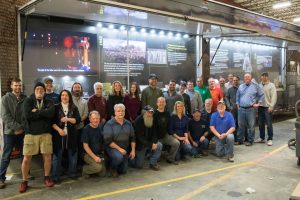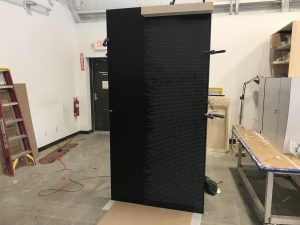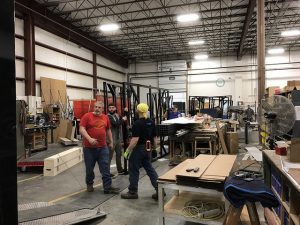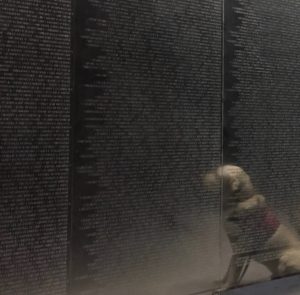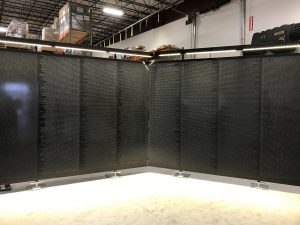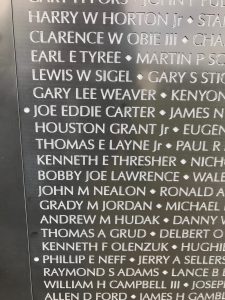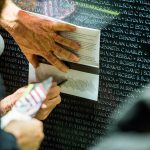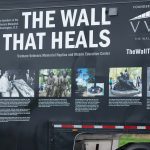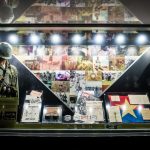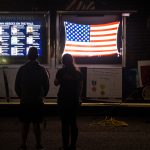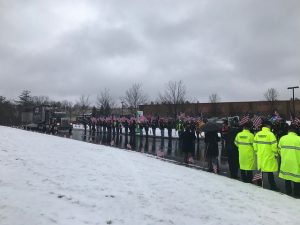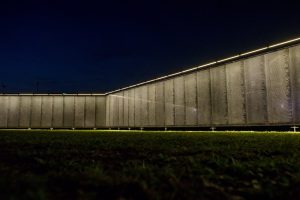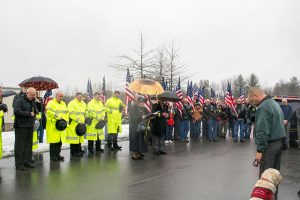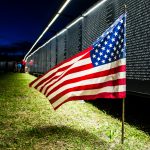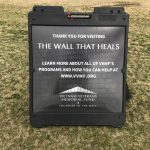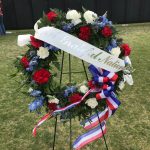Featured Project: The Wall That Heals – Vietnam Veterans Memorial Replica – a Look Behind the Scenes
After nearly 10 years, the Vietnam Veterans Memorial Fund (VVMF) knew it was time to replace the Vietnam Veterans Memorial mobile exhibit of the replica wall, The Wall That Heals. They sent out a request for proposal (RFP) to contractors they thought might be able to handle the project. Creatacor, a full turnkey exhibit display house based in Clifton Park, New York, having completed several smaller projects previously for the VVMF, jumped at the chance to submit their bid and was selected to build the new Wall. Their build included a unique mobile design using Avonite® Eclipse solid surface. The selection process was completed at the end of December of 2017, leaving Creatacor only 7-8 weeks to complete this exciting project.
Creatacor, which employs between 50-55 people just 20 minutes north of Albany, New York, is known by many in the display industry for its state-of-the-art custom fabrication techniques. These techniques have resulted in unforgettable exhibits and inline displays in corporate and retail environments, in interactive kiosks and sets for both television and stage. In essence, Creatacor believes in using the talents of their creative, problem-solving team to come up with just the right solution for every unique situation.
Laying the Groundwork for Teamwork
Creatacor received the RFP early in December and immediately began sourcing the materials for a sturdy frame, for the walls and for the actual engraving in anticipation of the possibility of being awarded the contract. Once Creatacor was awarded the project, everyone lit on fire! Dave West was selected as Project Manager, laying the groundwork for what they needed. Julian Colbert, in charge of procurement, had already reached out to vendors just in case the project came through. Each vendor contacted was equally excited about the possibility of being part of this historic project. The vendors were even required to sign a non-disclosure agreement, so word of the project would not get out.
Because this special project meant so much to many of the executives, managers and employees of Creatacor, everyone wanted to be a part of it. Creatacor is a close-knit company with a family-style atmosphere where they all “see a need and fill a need,” according to the Project Lead, Cathy Miller. This project touched so many people within the company who were linked to The Wall one way or another through family members who had served, both those that lost their lives and those that came home.
Project Specs
The specs for this unique project were provided by the VVMF and were very detailed. It was to be an exact replica of The Wall in Washington, DC, scaled to three-quarters of the original Wall. The new mobile Wall would need to accommodate the more than 58,000 names of the men and women who made the ultimate sacrifice. The panels could not exceed 75 pounds each to keep it mobile. Creatacor developed a mathematical template for each sectioned panel. Each panel contained a list of names (section 1). In the margin there was a counter dot for every 10 lines (section 2). At the bottom was the panel number (section 3). The VVMF also sent over a Word file with all of the names to be engraved on the Wall. The Word file then had to be transferred to another program in order to be read by the CNC machine.
The Right Materials
Each of the materials Creatacor selected for this project was chosen very carefully. An aluminum framework was crafted to hold each of the panels. Heavier steel was used for the support legs. Creatacor’s Fabrication/Engineering Manager, Brandon Verdu, designed the frames so that the panels could be removed from the frames and fit into the trailer for travel. The frames are bolted together and set up so that four panels slide into one section of the frame, making it easier to setup and teardown at each destination.
When it came to the selection of actual materials to build the wall panels, Creatacor looked for the most durable, shiniest and blackest material they could find so that it would be reflective, just like the original Wall. Natural materials such as granite or quartz were ruled out immediately as they would be far too heavy to move conveniently. With these parameters in mind, Creatacor made the easy decision to use Avonite® Eclipse solid surface material.
Brandon was also tasked with figuring out exactly how much of the Avonite® Eclipse solid surface was needed. With The Wall being a chevron shape, 8’ sheets of solid surface material would be required for the bigger walls. The smaller walls would only require ½ sheets of material. The material then had to be cut accordingly to create the 144 individual panels.
The finished solid surface exhibit of The Wall That Heals is 375 feet long and stands 7.5 feet high at the tallest point. It is scaled at three-quarters of the Vietnam Veterans Memorial located north of the Lincoln Memorial on the National Mall in Washington, D.C.
Aristech Solid Surface
Sourcing the solid surface material proved to be more difficult than anticipated. Cathy Miller said that when Creatacor initially contacted Timothy A. Maiuri, the Territory Sales Manager at Aristech Surfaces LLC, he told them it would take 11 to 12 weeks to provide Avonite™ Eclipse solid surface material that was needed for the project. By the time Creatacor got news that they had been selected to design the project, there were only 8 weeks remaining until the deadline. When Timothy became aware of the tighter deadline and was told this was for The Wall That Heals, he took immediate action. Having had two cousins and a brother whose names were on The Wall, he knew the importance of this project. Aristech stopped work on other productions for a few days to ensure Creatacor would have the Avonite in time.
Engraving the Solid Surface
The longest part of the project was the routing or engraving of the names and symbols which was scheduled to take 5 weeks or about 500 hours. Before this could happen, there were many hours spent checking and rechecking details against the original Wall in Washington, DC.
Once the buffing, cleaning and routing out of each sheet of Avonite® was completed and approval was given, Creatacor set up the files, put these into elevations, and loaded this information into a different program. Because of the crunched timeline, they enlisted the help of H. Loeb to do the engraving of the names since they had more than one CNC machine.
The Significance of the Symbols
Few people realize that The Wall in Washington, DC, changes yearly. There are symbols–diamonds and crosses–on The Wall indicating a service member’s status. Diamonds signify that the service member is confirmed dead or KIA. Crosses indicate MIA – missing in action. When a service member’s remains are accounted for, the diamond is superimposed over the cross.
Names are listed in chronological order by date of death so each panel represents a period of time. Inside each day, names are listed in alphabetical order. When a name is added, it is added to the end of a line as close as possible to the service member’s casualty date. To find the location of a name on The Wall, one can search on VVMF’s website on the Wall of Faces at www.vvmf.org/thewall or through “The Wall” app available through the App Store or Google Play.
It is anticipated the new Avonite® solid surface wall will be in circulation for at least 10 years. During that time, names may be added to the exhibit by Creatacor. If status changes need to be made, Creatacor has trained VVMF staff to be able to make status changes.
The engraving is one of the highlights that make the mobile version of The Wall That Heals a little more like visiting the actual Wall. People will now be able to take a piece of paper and a pencil and rub over the name of their loved one, making their own personal remembrance to take home with them.
The Lighting
Creatacor sourced out the lighting based on the specs given to them by the client, Tim Tetz of the VVMF. The lighting had to be soft, yet able to cast light far enough. It also had to be light enough in design so that people would not be tempted to hang on it (as happened with the previous wall). They chose LED lighting and used Hartranft Lighting Design to supply the lighting materials. Dave, the Project Manager, who also happens to have an electrician background, was able to put it all together at the Creatacor facility. The lights were designed to clip onto each panel and cast just the right amount of light back onto the shiny black solid surface wall panels.
The Mobile Education Center
Under a separate RFP, Creatacor was once again awarded the contract to outfit the brand new 53-foot trailer. For the vignettes, Creatacor built the windows and graphics. The VVMF supplied the artifacts and memorabilia. Real letters and images of actual documents were reproduced for the exhibit.
The Education Center provides teachable moments in each of the communities along the way for the younger generations to learn about honoring those in uniform who served and sacrificed so much.
Making the Deadline
Though the project timeline was incredibly tight, Creatacor managed to complete it with only minutes to spare. The Wall That Heals was scheduled to leave on February 23, 2018, at 4:00 p.m. The Creatacor team shut the doors to the trailer at 3:50 p.m.
The team was truly afraid they were not going to make the deadline. The deep meaning of the project itself kept everyone constantly motivated – they were in it to win it – it was very emotional and an extremely exciting project to be a part of. VVMF members Patrick O’Neill (Site Manager) and Tim Tetz (Director of Outreach) were awesome to work with. They kept saying if you want it done on time, you need to take the emotion out of it. Everyone at Creatacor was in it with their hearts making sure everything was perfect. The message from the top, coming from COO Will Farmer, was “this is not just a business, this is not just a project–these are our people, we can do this for them.” Everyone was each other’s cheerleader, always cheering each other on to the finish.
Unveiling the Finished Product
So many of the people who worked on the project had ties to it one way or another. The feeling of respect everyone at Creatacor has for those who put on a uniform was abundantly evident throughout the project. Everyone there held this project close to their chest, to honor the service members because they deserve it.
The Patriot Guard was called in to escort The Wall That Heals on its journey to its first destination which was Portland, Texas. It had to be there and set up by March 1, 2018. Employees of Creatacor and local veterans in New York were given the opportunity for a private preview of 20 feet of the new Wall. There was even a veteran from WWII there to appreciate the experience along with them.
The weather was stormy, playing right into the solemn anticipation of the spectators. The Sheriff and state and local police and fire departments were there to see the trailer off properly. A Gold Star Mother offered up a prayer just before the trailer left. It was very emotional for everyone.
A true appreciation for the amazing teamwork and eventual scope of the project became even more evident to the team at Creatacor when they watched a lone Vietnam Veteran walk quietly to The Wall, place both hands on it and stood to remember as his eyes filled with tears.
For more information about The Wall that Heals and Creatacor:
Vietnam Veterans Memorial Fund
Creatacor Press Release for The Wall That Heals



